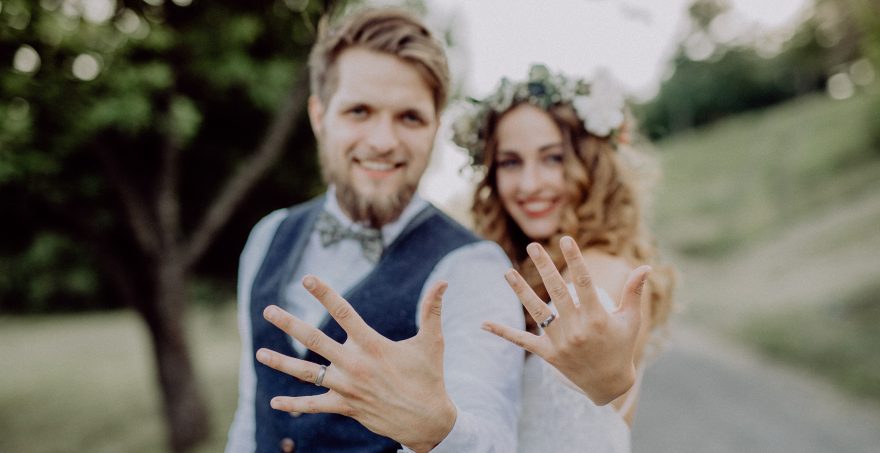Do Wedding Rings Have Any Real Meaning?
by David Gibson

Publishers forward lots of books to me every year about marriage because of my writing for this website. I always am surprised by how frequently wedding rings are depicted in the cover designs for these books.
Yet, next to nothing tends to be discussed or explained about wedding rings inside these books. In fact, I found no mention of wedding rings inside one book whose very title referred to them.
Obviously, though, wedding rings are important to couples planning to wed. Many couples invest large amounts of time in the selection of rings. The sheer cost of wedding rings, moreover, suggests they have real meaning for couples.
But what precisely is this meaning?
One book sent to me, the ninth edition of Jesuit Father John L. Thomas’ “Beginning Your Marriage,” spoke about wedding rings in a discussion of symbols. “The bride and groom usually give each other rings in the shape of a circle, symbolizing that they hope that their love will be without end,” the book observed.
Explaining a wedding ring’s meaning might pose a challenge for more than a few of us. And over time, some of us likely would realize that our earlier understanding of this meaning only scratched the surface.
Those are some of the reasons a little piece Father Stephen Wang wrote a few weeks ago on wedding rings captured my attention. Father Wang, a British Catholic theologian, authors a blog titled “Bridges and Tangents” that explores a wide variety of current issues.
A “Moment of Revelation”
“I had a small moment of revelation about the meaning of wearing a wedding ring” during a recent wedding, he said. “It’s not an exaggeration,” he added, “to say that my understanding was turned completely upside down.”
On the level of popular culture, a wedding ring’s significance probably would be found in the message it conveys that a person already is married and committed to one particular person. That message is true enough, as Father Wang noted.
His primary point appeared to be, however, that this is an incomplete explanation of a wedding ring’s purpose.
Father Wang pointed out that in some films a character “plotting how he might hook up” with a stranger “slips his wedding ring off and puts it in his pocket.” The intent is to deceive his new acquaintance.
The assumption is that by wearing a wedding ring, people acknowledge their marital commitment publicly and in a continual way.
Father Wang did not deny the value of this wedding ring role. However, his primary message was that during a recent wedding he heard, “as if for the first time,” the message about these rings communicated by the church’s wedding liturgy.
Whose Commitment Is Signified?
“I’ve always thought that wearing a wedding ring was a sign of the commitment ‘you’ are making to your spouse and to your marriage” – that the ring is a “constant sign of your own rededication and recommitment to this relationship,” as well as a means of acknowledging that publicly, he said.
But he realized that day that “this is absolutely not what the wearing of the ring signifies.” The words of the church’s wedding rite that he heard so uniquely that day state:
“Take this ring as a sign of my love and fidelity.”
Thus, Father Wang commented, “the ring that is given is a sign of the love and fidelity of the one who gives it.” He continued:
“The ring that you wear, that was placed on your finger by your spouse on your wedding day, does not represent your commitment to your marriage, your love for your spouse, your faithfulness. … It represents the commitment, love, and faithfulness of your spouse to you.”
Paulist Father Lawrence Rice made a similar point when he commented on wedding rings in an article a while back on this website titled “Things You Won’t See at a Catholic Wedding.”
He pointed out that a “touching moment in most TV weddings is the phrase, ‘With this ring, I thee wed.’”
However, Father Rice said, for Catholics “the moment of the marriage is the exchange of consent and the speaking of the vows. The ring is a symbol of the union that has already taken place.”
He, too, noted that the rings, after being blessed during the wedding, “are exchanged with the phrase, “Take this ring as a sign of my love and fidelity, in the name of the Father, and of the Son, and of the Holy Spirit.”
For Father Wang, it was a “moment of revelation” when he realized that, from the perspective of the wedding liturgy, “the ring is not there, first of all, as a sign of your continuing commitment to this person (although of course, it can come to mean that as well).”
The ring is, he said, “a reminder of the promise that another has made to you and of the promise that God has made to you both.”
He concluded, “I know that life and marriage are not always tidy or easy, but I think there is a truth worth pondering here.”
About the author
David Gibson served for 37 years on the editorial staff at Catholic News Service, where he was the founding and long-time editor of Origins, CNS Documentary Service. David received a bachelor’s degree from St. John’s University in Minnesota and an M.A. in religious education from The Catholic University of America. Married for 38 years, he and his wife have three adult daughters and six grandchildren.




